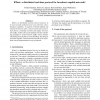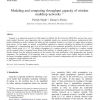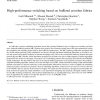1502 search results - page 79 / 301 » Node weighted scheduling |
NETWORKS
2010
13 years 8 months ago
2010
The input to an Inverse Shortest Path Lengths Problem (ISPL) consists of a graph G with arc weights, and a collection of source-sink pairs with prescribed distances that do not ne...
ICAS
2005
IEEE
14 years 3 months ago
2005
IEEE
RTnet is a distributed real-time network protocol, to be used on fully-connected local area networks with a broadcast capability. It supports on-the-fly addition and removal of n...
CN
2008
13 years 10 months ago
2008
Capacity is an important property for QoS support in Mobile Ad Hoc Networks (MANETs) and has been extensively studied. However, most approaches rely on simplified models (e.g., pr...
CORR
2010
Springer
13 years 5 months ago
2010
Springer
Treemaps are a popular technique to visualize hierarchical data. The input is a weighted tree T where the weight of each node is the sum of the weights of its children. A treemap ...
CN
2006
13 years 10 months ago
2006
As buffer-less crossbar scheduling algorithms reach their practical limitations due to higher port numbers and data rates, internally buffered crossbar (IBC) switches have gained ...



